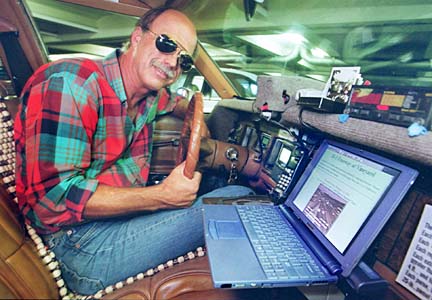Advertisement - Click to support our sponsors.


Cabbie has
high-tech world
in old car
His passengers can take a trip
By Treena Shapiro
on the information highway
in the '79 Pontiac
Star-BulletinJohn Parker describes his 1979 Pontiac Bonneville taxi as a "virtual total wreck" when he bought it two years ago. But since then, he has built a virtual new world inside the cab.
Outside, the beige car is nicked and scratched; inside, computer and camera equipment overflow the carpeted dashboard. A ball-shaped Web camera is aimed at the back seat, while a miniature television hangs near the radio. And, supported by a series of elbow braces, a clipboard serves as a desk for a Sony laptop, which juts out over a videocassette recorder loaded with eight-hour tapes. Screws, duct tape and carpet keep it all in place.
Not only can Parker take you on Kalanianaole Highway, ride with him and you can cruise the information superhighway, too. His passengers can send or receive email and faxes or surf the Internet via a wireless connection.
"I haven't played with computers since the '60s," Parker, 52, said. "The first time I got on the Internet was in November when I hooked it up in my car."
"All of this was born out of necessity and need," he explained. He said he has been robbed three times. Now all of his customers are digitally photographed the minute they step into his cab, their images saved to his hard drive. He had to argue about an accident in court. Now he videotapes his travels so there will be no question of fault if he is in an accident in the future.
Parker also uses his computer to check the Honolulu Traffic Camera Web site. The images are from the traffic cameras in 69 locations on Oahu. Parker can check the traffic and pick the best route to get to his destinations.
"The real plum of the system is the ability to see traffic in front of me," Parker said. "I can see right on street level what the traffic looks like at any major intersection."
Parker also runs Global Positioning System software, which uses satellites to help him locate his current position and destination. Parker admits his setup is not really practical ... yet.
"I still haven't given up on the Bryan's map book," Parker said, patting the spiral-bound Oahu maps on his dashboard.
His wireless Internet connection is slow, sometimes taking more than 30 seconds to load an image, and Parker has to use the keyboard and mouse to change the maps. "It's like Edison's phonograph," Parker explains. "It's clumsy and crummy in its own right, but it works."
Capt. Bryan Wauke in Honolulu Police Department's Traffic Division said using a computer while driving raises safety questions. "We need to make laws to address that," he said. "Anything that takes their eyes away from the roadway while driving can be dangerous. It only takes a second or two before changes in traffic occur."
Parker said he is aware that mixing cars and computers can be hazardous. "It is dangerous for the general public to use -- so are cell phones -- but it's coming. We can't stop it."
According to Parker, using the keyboard and mouse takes the same amount of time and attention it takes to adjust the radio, and looking at the images is like looking at the speedometer.
Parker also sees potential safety improvements -- voice-operated systems and buttons on the steering wheel -- and perhaps a whole new local industry built on computers in cars.
Don Hamada, chief of Honolulu's Traffic Control Division, which operates the traffic camera system, said he is not surprised at the way Parker has taken advantage of it. Traffic control has been a partner with the University of Hawaii College of Engineering to try to find a way to bring new and upcoming technology safely into everyone's cars.
Hamada envisions voice-operated systems and smaller, brighter screens built into the dashboard or windshield. And, as wireless connections get faster, static photographs could be replaced by video so drivers would actually be able to see how the traffic is moving in front of them.